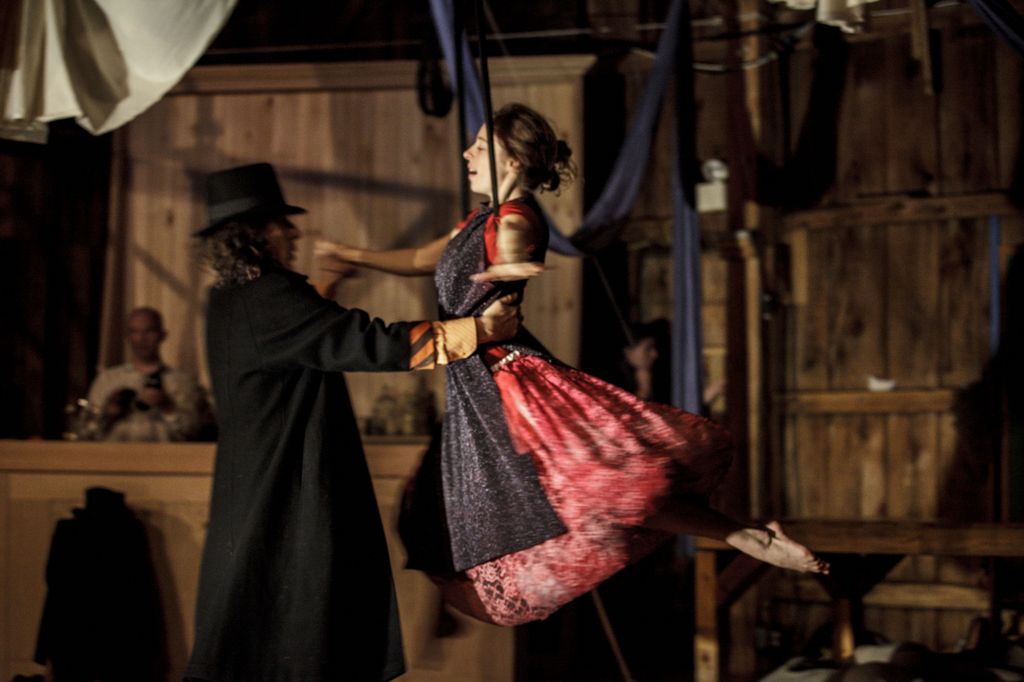
by Lauren Warnecke, MS
So you’ve managed to make a dance. How do you know when it’s really finished? When your music runs out? After about 20 minutes? When you run out of “moves”?
Rule number one in finishing a dance is a narrative arch. This doesn’t necessarily mean you have to tell a linear story, but each dance must have a clear beginning, middle, and end. Where you choose to place arches within these sections is largely up to you, but they are important for guiding your audience along the journey.
Once your journey is up, so is your dance, but choreographers often find themselves dissatisfied and wondering if the dance is, in fact, finished. The Grand Parade, created and performed by Double Edge Theatre at The Dance Center of Columbia College last Saturday is a piece with a strong narrative and massive production elements that include a fury of projections, mannequins, rigging for aerial circus arts, and perhaps a few hundred props. Yet, even with all these things going on, Double Edge’s history of the 20th Century in 55 minutes is a work they insist is not yet done. Seeing The Grand Parade reinforced my view that no work is ever, really, done.
A colleague of mine once said of her work, “It’s not done, but I’m done with it.” She viewed a performance as a slightly more formal Works-in-Progress showing… with fancier lights.
I think her point speaks to the idea that dance is a living, evolving art form. Dances have a transient nature that is unlike, say, visual art. The Sistine Chapel will always be the Sistine Chapel, but Peptipa’s choreography will be ever changing to a certain degree based on the venue, the dancers, tempo choices, costume, etc.
On a more contemporary note, sometimes it is only through live performance that you truly learn about a piece and see what it needs. You might figure out that your ending is really awkward and the audience doesn’t know when to clap. Or you might discover that you want the whole thing to be presented in reverse order to what it is. The stage is a beautiful place to discover these things, but that’s not to say that everything is stage-worthy…
Ultimately, you’re asking patrons to pay money to watch your product. Most people wouldn’t fork over $12 to see an unfinished movie, and besides, that’s what free or inexpensive WIPs are for. But given the inevitable stages of development a dance undergoes, it may need to be presented multiple times, in multiple iterations. Each iteration that takes to the stage, however, should a finished quality that is worth paying for. These are a few things I look for in a “finished” dance:
1) Well-rehearsed dancing – If we can’t tell whether your dance is in unison or canon, or whether or not you’re supposed to be standing in a straight line, three things are happening to your audience members: a) we are spending time wondering if this section is bad unison or a bad canon, b) we have stopped paying attention to the deep, inner meaning of your choreography, and c) it’s obvious you are under-rehearsed.
People in the lay population (that is, “real” people without dance training) love The Rockettes. This is not because of the metaphorical, life-changing questions that come out of watching a show at Radio City Music Hall, it’s because 24 chicks in heels, standing in a straight line, kicking to exactly the same height at exactly the same time is really impressive to watch. The work and training that goes in is apparent, and I’m willing to pay for that.
I should add: My standards become higher based on ticket price, and the dancers’ pay grade. While it might seem unfair, I expect and demand the big name companies to be well-rehearsed while there’s a little leniency for a company that I know is paying dancers $100 for six months of work, and only can afford to rehearse once a week. This, is another problem entirely that won’t be discussed here…
2) Production elements –What often makes dance so special is the spirit of collaboration with other artsy genres that comes with putting on a dance performance. Lights, music, costume, make-up, video, scenery… our ancestors at The Ballets Russes reveled in utilizing many different elements aside from just dance to create a world on stage. Even Balanchine, who stripped the ballet of its scenery and costumes, was known for the original music Igor Stravinsky created for his ballets. Personally, I can get behind four dancers moving on a blank stage in silence, but I feel that many choreographers have missed opportunities to “finish” their dances by failing to incorporate elements that heighten the production value.*
Aside from collaboration, production elements help convey meaning. Costumes, lights, and props/scenery sometimes help us to understand what we’re looking at. What is your piece about, and what do those gaucho pants and tank top say about it? Nothing? Oh…
In the end, what do I know?!? Anything and everything I’ve said above is completely subjective. But to drive my point home I’ll revisit the idea that dance is an impermanent art form. This is its greatest strength, AND its greatest weakness. The idea that each work is never done is, as an artist, freeing. As an audience member, it can sometimes be neat, and sometimes incredibly frustrating. Part of embracing the nature of dance (and getting others to embrace it with their pocketbooks) is by finishing what, in reality, can never be finished, and by coming to the conclusion that, though not done, you’re done with it.
*Side note: Production elements, like the dancing, should too be well-rehearsed. And, a little CAN go a long way (but this is the topic of another post…).

Contributor Lauren Warnecke, M.S., is a Chicago-based dance artist, educator, and writer. She trained at the Barat Conservatory of Dance before earning a BA in Dance at Columbia College Chicago. In 2009, Lauren completed her MS in Kinesiology at the University of Illinois at Chicago, with a concentration in Motor Control and Learning. Lauren is a Visiting Instructor for the department of Kinesiology and Nutrition at UIC, and teaches master classes and seminars in ballet, modern dance, creative movement, and dance pedegogy. She is certified in ballet by the Cecchetti Council of America and a member of the American College of Sports Medicine.
In addition to teaching at UIC, Lauren owns and operates Art Intercepts, under which she creates, informs, and writes about dance. The primary mission of Art Intercepts is to bridge the gap between the scientific and artistic communities to present programming that is informed, inventive, and evidence-based. Lauren is a freelance writer/blogger and maintains monthly columns at Danceadvantage.net and 4dancers.org. and is featured on a panel of nationally reputed dance writers at the 2012 Dance/USA conference. She also works periodically as a grant writer and production/stage manager for artists in the Chicago dance and performance community, and volunteers for initiatives encouraging Chicagoans to engage in local, sustainable, and active lifestyles. Lauren likes to hike, bake scones, and dig in the dirt.





The way you construct your dances are always important. You want to make sure your audience is constantly engaged. You are completely correct when you say that your choreography needs to have a begining, middle, and an end. I’ve seen dances where the ending wasn’t very clear….it was hard to watch.
Endings are sometimes the hardest part! Sometimes you want to leave the weird taste in their mouth… and sometimes the audience just doesn’t know when to clap. Thanks for your comment, Josie, and for reading!